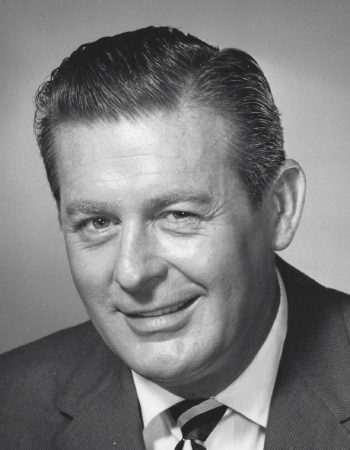Donald John DeFore emerged as a prominent actor, philanthropist, and entrepreneur. His career spanned over five decades, during which he graced the silver screen, conquered television, and endeared himself to audiences with his affable demeanor. This article delves into the fascinating biography of Don DeFore, tracing his remarkable journey from a small town in Iowa to the glitz and glamour of Hollywood.
Early Life and Education:
Don DeFore’s story begins in Cedar Rapids, where he was born to Herman and Louise DeFore. Raised in a middle-class family, he attended Washington High School, where his interest in acting first blossomed. DeFore’s early exposure to local theater productions ignited a passion that would shape his future. After high school, he pursued his dreams by enrolling at the Pasadena Community Playhouse in California, a decision that marked the beginning of his journey into the world of entertainment.
Hollywood Debut and Early Career:
DeFore’s early career in Hollywood was marked by small roles and bit parts. His debut came in the 1937 film “The Road Back,” a sequel to the acclaimed “All Quiet on the Western Front.” Despite the modest start, DeFore’s talent did not go unnoticed. He soon found himself cast in a variety of supporting roles, showcasing his ability to portray diverse characters with equal finesse.
World War II Service:
As World War II engulfed the world, DeFore patriotically put his acting career on hold to serve his country. Enlisting in the United States Coast Guard, he dedicated four years to military service. His commitment and bravery were recognized, earning him a commendation for his exemplary performance during his service. After the war, Don DeFore returned to Hollywood, not only as an actor but also as a decorated war veteran.
Post-War Success and Stardom:
The post-war era witnessed a surge in DeFore’s career. He transitioned from supporting roles to leading man status, showcasing his versatility in both comedic and dramatic roles. His notable performances include “Too Late for Tears” (1949) and “Ramrod” (1947), cementing his status as a reliable and talented actor. However, it was his comedic flair that truly set him apart.
Television Triumph:
While Don DeFore had already established himself as a silver screen presence, it was the burgeoning medium of television that provided a new avenue for his talents. In 1953, he began starring in the popular sitcom “The Adventures of Ozzie and Harriet,” where he played Thorny Thornberry, the Nelsons’ affable neighbor. The show became an instant hit and ran for an impressive 14 seasons, solidifying DeFore’s status as a household name.
In addition to his role on “Ozzie and Harriet,” DeFore made numerous guest appearances on other popular television shows of the time, including “Make Room for Daddy” and “The Twilight Zone.” His television success showcased his adaptability, endearing him to a new generation of viewers.
Entrepreneurship and Philanthropy:
Beyond his acting career, Don DeFore was a shrewd businessman and a dedicated philanthropist. In the 1950s, he ventured into the restaurant business, opening the renowned Don DeFore’s Silver Banjo restaurant in Los Angeles. The establishment became a popular haunt for celebrities and locals alike, a testament to DeFore’s entrepreneurial acumen.
Equally passionate about giving back to the community, DeFore became involved in charitable endeavors. He served as the president of the National Academy of Television Arts and Sciences and was instrumental in various charitable organizations, including the Motion Picture and Television Fund. His commitment to philanthropy reflected a deep sense of social responsibility, showcasing a side of Don DeFore beyond the glitz and glamour of Hollywood.
Later Career and Legacy:
As the 1960s unfolded, Don DeFore continued to work steadily in both film and television. His enduring popularity allowed him to navigate seamlessly between the two mediums, leaving an indelible mark on both. Notable appearances include roles in “The Andy Griffith Show” and “Hazel.”
In the twilight of his career, DeFore embraced character roles with the same gusto that marked his earlier years. His final film appearance came in the 1991 comedy “My Girl,” where he shared the screen with the likes of Dan Aykroyd and Jamie Lee Curtis.
Don DeFore’s legacy extends beyond his acting prowess. His contributions to the entertainment industry, coupled with his philanthropic efforts, solidify his place as a beloved figure in Hollywood history. He passed away on December 22, 1993, leaving behind a body of work that continues to captivate audiences and inspire aspiring actors.
Conclusion:
Don DeFore’s journey from the heartland of America to the heart of Hollywood is a testament to his talent, resilience, and enduring charisma. His ability to seamlessly transition between film and television, coupled with his entrepreneurial spirit and commitment to philanthropy, sets him apart as a true icon of the entertainment industry. Don DeFore’s legacy lives on, not only in the reels of classic films and television shows but also in the hearts of those who continue to appreciate his contributions to the golden age of Hollywood.
-
Who is Don DeFore?
- Don DeFore, born on August 25, 1913, in Cedar Rapids, Iowa, was a versatile actor, entrepreneur, and philanthropist. He gained prominence during Hollywood’s Golden Age and had a career that spanned over five decades.
-
What were Don DeFore’s early years like?
- DeFore grew up in a middle-class family in Cedar Rapids and attended Washington High School. His interest in acting was sparked during local theater productions. He later pursued his passion at the Pasadena Community Playhouse in California.
-
When did Don DeFore start his career in Hollywood?
- Don DeFore made his Hollywood debut in 1937 in the film “The Road Back.” Initially, he played small roles, but his talent and versatility quickly caught the industry’s attention.
-
How did World War II impact Don DeFore’s career?
- Don DeFore put his acting career on hold during World War II and served in the United States Coast Guard. His dedication and bravery earned him commendations for his exemplary service. After the war, he returned to Hollywood as both an actor and a decorated war veteran.
-
What were some of Don DeFore’s notable film roles?
- Don DeFore had a successful post-war career with leading and supporting roles in films such as “Too Late for Tears” (1949) and “Ramrod” (1947). His ability to portray diverse characters contributed to his popularity.
-
How did Don DeFore transition to television?
- In 1953, Don DeFore began starring in the popular sitcom “The Adventures of Ozzie and Harriet,” playing the character Thorny Thornberry. The show ran for 14 seasons, establishing DeFore as a household name. He also made guest appearances on other popular shows like “Make Room for Daddy” and “The Twilight Zone.”
-
Did Don DeFore have success outside of acting?
- Yes, in the 1950s, Don DeFore ventured into the restaurant business, opening the renowned Don DeFore’s Silver Banjo restaurant in Los Angeles. He showcased his entrepreneurial skills alongside his acting career.
-
Was Don DeFore involved in philanthropy?
- Absolutely. Don DeFore was dedicated to philanthropy and served as the president of the National Academy of Television Arts and Sciences. He was actively involved in various charitable organizations, including the Motion Picture and Television Fund.
-
What were Don DeFore’s later career highlights?
- In the 1960s and beyond, Don DeFore continued to work in both film and television, embracing character roles. His final film appearance was in the 1991 comedy “My Girl.”
-
What is Don DeFore’s legacy?
- Don DeFore’s legacy extends beyond his acting career. His contributions to the entertainment industry, coupled with his entrepreneurial ventures and philanthropy, solidify his place as a beloved figure in Hollywood history.
These FAQs provide a glimpse into the life and career of Don DeFore, offering insight into the various facets that made him a remarkable personality in the entertainment industry.

